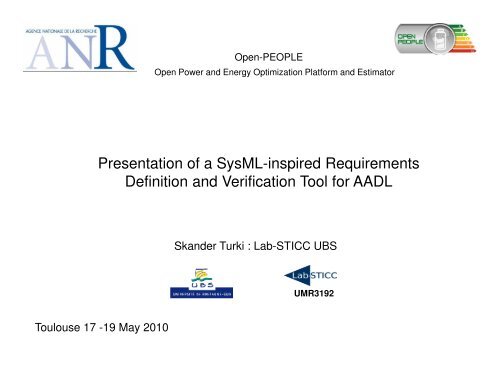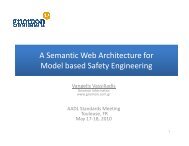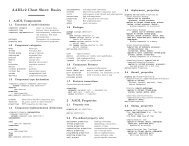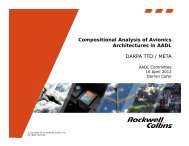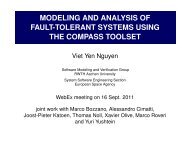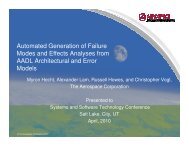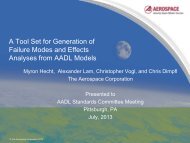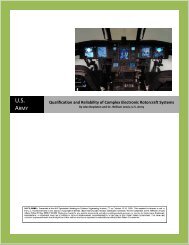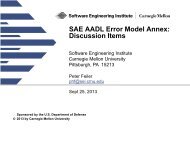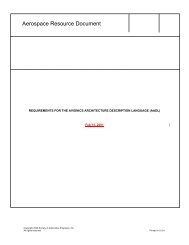Requirements Definition and Verification Tool for AADL
Requirements Definition and Verification Tool for AADL
Requirements Definition and Verification Tool for AADL
- No tags were found...
You also want an ePaper? Increase the reach of your titles
YUMPU automatically turns print PDFs into web optimized ePapers that Google loves.
Open-PEOPLEOpen Power <strong>and</strong> Energy Optimization Plat<strong>for</strong>m <strong>and</strong> EstimatorPresentation of a SysML-inspired <strong>Requirements</strong><strong>Definition</strong> <strong>and</strong> <strong>Verification</strong> <strong>Tool</strong> <strong>for</strong> <strong>AADL</strong>Sk<strong>and</strong>er Turki : Lab-STICC UBSUMR3192Toulouse 17 -19 May 2010
Outline• Introduction of the project• Introduction of the tool• Who uses the tool ?• The requirements metamodel• The graphical tool• Identifying use cases <strong>for</strong> constraints• Questions
The Open-People Project• Open-People is a french project intending tobuild a remote hardware plat<strong>for</strong>m <strong>for</strong> powerconsumption analysis.• <strong>AADL</strong> is the chosen language <strong>for</strong> the system’smodeling.• A dem<strong>and</strong> in this project was to add to the <strong>AADL</strong>toolchain (OSATE/Adele/CAT etc.) arequirements definition <strong>and</strong> validation tool.
Presentation of the <strong>Tool</strong>• We started by developing a graphical editor <strong>for</strong>only textual requirements (in<strong>for</strong>mal). Then weadded the possibility to write OCL or REALrequirements in the metamodel (graphical viewunder development).• We started developing the OCL constraintschecker that will validate the <strong>Requirements</strong>model against the <strong>AADL</strong> model.
Who uses the tool ? : <strong>AADL</strong> user• When building a model (M1), the user can define constraints that reference elements fromeither M3, M2, M1 or M0 : We are not talking about constraints built in the M2 or M3 level !• Identifying constraints use cases where the actor is the <strong>AADL</strong> language user.M3EMF/ MOFmeta-(meta-model)M2s1The <strong>AADL</strong> languageengineer works here.We are not talkingabout this actor.<strong>AADL</strong> meta-modelM1M0<strong>AADL</strong> model<strong>AADL</strong> modelinstances2The <strong>AADL</strong> user buildshis models here.We are onlyconcerned by thisactor.
Slide 5s1s2For users of the <strong>AADL</strong> language, M3 level must not be used to define constraints (meatclass Class should always have nameproperty…)sk<strong>and</strong>er, 5/16/2010For users of the <strong>AADL</strong> language, M2 level can be used to define additional constraints on model elements:when en<strong>for</strong>cing new semantics from an application domain (a system has always at least one processor).When en<strong>for</strong>cing specific design best practices (a thread should always be bound to a processor).When defining requirements on the system, in this case, the requirements should be separated from the <strong>AADL</strong> model (each processormust not consume more than xx energy)..sk<strong>and</strong>er, 5/16/2010
Graphicaleditor(<strong>AADL</strong>) <strong>Requirements</strong> <strong>Definition</strong> Meta-modelThis metamodel is inspired from SysML <strong>and</strong> theISO/IEC/IEEE 15288 SE st<strong>and</strong>ard. But SysML isa UML extension, so we needed to adapt it (InSysML a requirements group is represented by apackage instead of a class).Eclipse view
The <strong>Requirements</strong> graphical editor
s3Identifying use cases <strong>for</strong> constraints• Identifying contraints use cases :– First use case : Constraints that reflect a requirement expressed by the system’sspecification.– Second use case : Constraints that are part of the system’s model <strong>and</strong> that express adesign in<strong>for</strong>mation; They complete the <strong>AADL</strong> metamodel with additional constraints.• In the first use case we have found that it is better to separate the requirements modelfrom the design one.• In the second use case we found that it is better to have the constraints embedded in the<strong>AADL</strong> model. Example of the Electrical compatibility constraint in Jerome Hugues’ usecase with the REAL language :
Slide 8s3For users of the <strong>AADL</strong> language, M1 level can be used to define additional constraints on model elements:when en<strong>for</strong>cing new semantics from an application domain specific to this model element (in this model, a system has always at leastone processor).When en<strong>for</strong>cing specific design choices scecific to this model (in this model, a thread should always be bound to a processor).When defining requirements on the system, in this case, the requirements should be separated from the <strong>AADL</strong> model (each processormust not consume more than xx energy)..sk<strong>and</strong>er, 5/17/2010
Questions• Is there any interest <strong>for</strong> such a language in the<strong>AADL</strong> community?• Do we need a textual concrete syntax <strong>for</strong> ourrequirements language (<strong>AADL</strong> Annex)?• Would there be other specific needs <strong>for</strong> thegraphical editor?• Is the traçability enough?


